North Carolina’s coastline stretches over 300 miles, offering a vibrant habitat for an array of coastal birds of NC. From the sandy shores of the Outer Banks to the marshy estuaries of the Crystal Coast, these birds captivate birdwatchers, conservationists, and casual beachgoers alike.
Their diverse behaviors, striking plumage, and critical ecological roles make them a cornerstone of the state’s natural heritage. This guide dives deep into the world of coastal birds.
Whether you’re a seasoned birder or a curious traveler, this guide will enrich your understanding of these feathered wonders of Coastal Birds of NC. Declines hint at pollution or habitat loss. Brown pelicans, once nearly extinct, now soar again, proving conservation’s power. Birdwatching fuels tourism, drawing thousands to Cape Hatteras and beyond.
“Birds are indicators of the environment. If they are in trouble, we know we’ll soon be in trouble.” – Roger Tory Peterson
Key Takeaways:
- North Carolina’s coast hosts over 400 Coastal Birds of NC, including shorebirds, wading birds, and seabirds.
- Key species include brown pelicans, piping plovers, American oystercatchers, and least terns.
- Habitats range from beaches and marshes to estuaries and barrier islands.
- Conservation efforts protect endangered species from habitat loss and climate change.
- Birdwatching spots like Pea Island National Wildlife Refuge offer prime viewing opportunities.
1. Brown Pelican – Sovereigns of the Coastal Skies:
- Scientific Name: Pelecanus occidentalis
- Appearance: Grayish-brown body, white head in winter, yellow crown in summer, 6-7 ft wingspan
- Habitat: Coastal waters, sandy islands
- Behavior: Dives headfirst for fish, glides in V-formations
- Conservation Status: Recovered from endangerment, sensitive to oil spills
- Best Viewing Spots: Bird Island, Cape Hatteras National Seashore
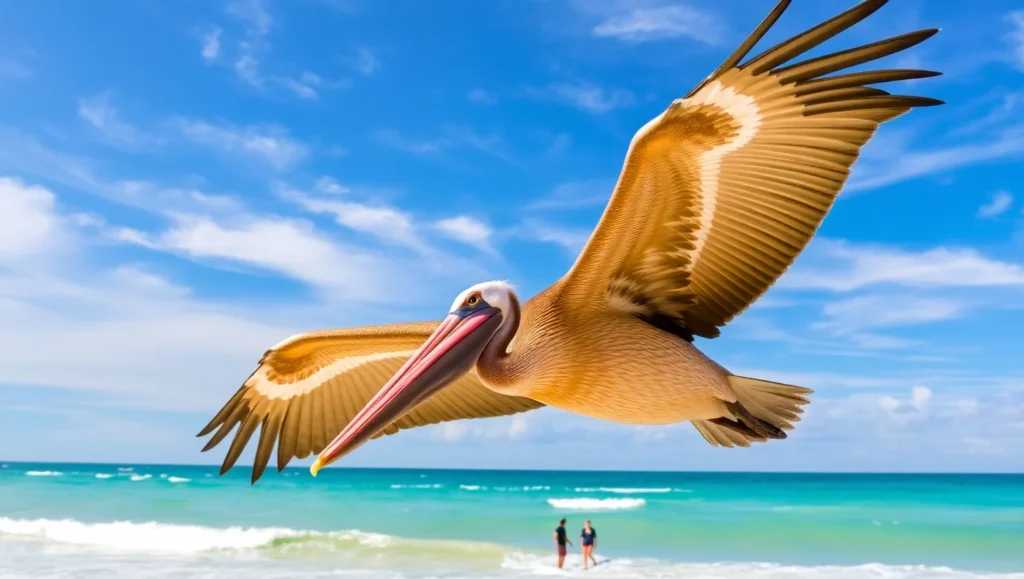
The coastline of North Carolina is the natural habitat of Brown Pelicans. These sea birds are capable of aerial dives from 60ft and will sequentially dive, using their throat pouches to scoop up fish such as menhaden.
Using their massive wings, they can glide using V formations which allows them to nest on the islands of the Cape Fear River where they will build nests using crude sticks and grass. There was a period in the 1970s when oil spills and human disturbance greatly reduced the population, but the change is promising now.
Birders from all over venture to Bird Island to view this spectacle, where the huge groups of pelicans make for breathtaking scenery against the backdrop of the sunset.
2. Piping Plover – Elusive Runners of the Shore:
- Scientific Name: Charadrius melodus
- Appearance: Small, sandy-colored, black forehead band in summer
- Habitat: Open beaches, dunes
- Behavior: Runs in bursts, probes sand for worms
- Conservation Status: Threatened, vulnerable to human disturbance
- Best Viewing Spots: Pea Island, Wrightsville Beach
This small species of shorebird has a superb hiding mechanism as they are remarkably camouflaged due to being able to seamlessly camouflage with the beaches along with their soft muted color resembling the color of the shore. Piping lowers indeed face two significant threats, such as storms along with careless beachgoers who pose a great deal of danger due to carving immense nests so shallow in the sand.
They, however, do make countless amounts of desperate calls that echo through the open waves as they can extract worms along with other crustaceans during their time in the gentle bursts of tides. Roped-off zones seem to be enormously restrictive in movement, but are a great help to the survival of lower piping as they need to be monitored very closely throughout their breeding season.
Along with the destruction-free environments of conservationists’ primary focus, from April to August. Along with being a piping plover enthusiast who seeks to observe the splendid pipes in all their beauty, the National Wildlife Refuge is indeed the best option, which easily gives great observing chances during spring.
MORE FOR YOU: 10 Types of Finches in Michigan (With Pictures)!
3. American Oystercatcher – Bold Sentinels of the Coast:
- Scientific Name: Haematopus palliatus
- Appearance: Black-and-white plumage, bright orange beak
- Habitat: Barrier islands, tidal flats
- Behavior: Cracks oysters with beak, patrols beaches
- Conservation Status: Stable, needs protected beaches
- Best Viewing Spots: Masonboro Inlet, Bird Island
The North Carolina coast is strutting ground for the American oystercatcher and sharp-eyed beachgoers will have no trouble identifying the bird due to its striking black-and white feathers in addition to its vivid orange beak. Their sturdy bills are used to pry open oysters and clams which contributed to their name.
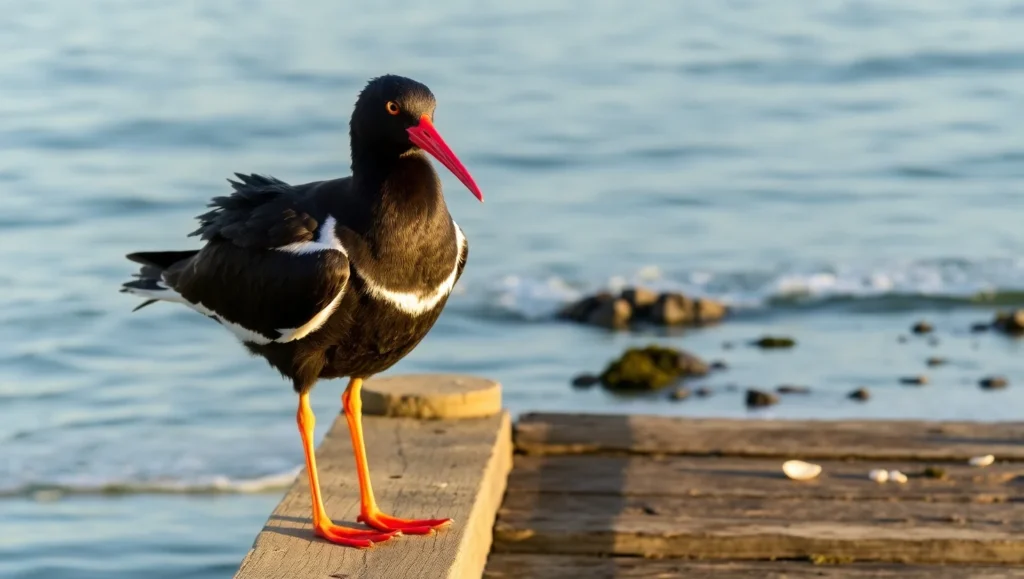
Their loud, whistling “wheep” calls let you know of their presence, often but not always before they are seen. Sightings of the birds are possible year-round as they patrol the beaches foraging at low tide.
Audubon North Carolina protects them from coastal development by reserving Bird Island, enabling them to lay speckled eggs in natural digs found in the sand. The nest is home to the fledgling baby birds, which watch in wonder-ready at the bottom of the sand. Pulling towards the Masonboro Inlet during dawn is recommended to witness the birds feeding from the towns.
4. Least Tern – Agile Fliers of the Sandy Shores:
- Scientific Name: Sternula antillarum
- Appearance: Small, grayish-white, black cap in summer, forked tail
- Habitat: Sandy beaches, rooftops
- Behavior: Hovers, dives for fish, noisy colonies
- Conservation Status: Threatened by habitat loss
- Best Viewing Spots: Sunset Beach, Outer Banks
The least terns are a stunning sight on the beaches of North Carolina. The smallest tern species weighs around 55-90 grams and has grayish-white bodies, forked tails, and black caps that protect them during breeding season. They use their rapid wingbeats to hover and agilely fly while diving for fish like anchovies.
Their loud calls are shrill and screeching. Coastal erosion is one of the many threats to their nesting sites, and as a result, protective measures like fencing and signage are implemented. Conservationists are dedicated to protecting the birds and work to shield inflatables from storms and predators. You may visit Sunset Beach during the summer to see snug-acrobatics, but be mindful of protected areas as they enclose their nests.
“Look at the birds of the air; they do not sow or reap or store away in barns, and yet your heavenly Father feeds them.” – Matthew 6:26
MORE FOR YOU: Discover Doves in Arkansas – Species, Habitats & Tips!
5. Great Egret – Graceful Hunters of the Marshes:
- Scientific Name: Ardea alba
- Appearance: Snowy white, long neck, yellow beak
- Habitat: Marshes, estuaries
- Behavior: Wades slowly, spears fish
- Conservation Status: Stable, needs wetlands
- Best Viewing Spots: Rachel Carson Reserve, Intracoastal Waterway
In the marshes of North Carolina, great egrets strut around in utter elegance. The thick Canada Geese cousins are known for stalking the shallower waters where they freeze until a fish or frog surfaces, which they snag with their elongated beak.

Accompanied by white, snowy feathers draped on the neck, the whole combination creates a striking silhouette of the blue cordgrass. During the breeding season, they use delicate, lacy plumes, known as aigrettes, crafted for their beauty.
Their populations remain a cause for concern due to pollution; this control is aided significantly by the preservation of wetlands. nbsp; When visiting the Rachel Carson Reserve, Capturing shots of egrets wandering around tidal flats does not go begging for one’s attention; with the low tide reflecting shimmering water, their images only enhance the beauty of nature around.
6. White Ibis – Sociable Foragers of the Tidal Flats:
- Scientific Name: Eudocimus albus
- Appearance: White feathers, curved red beak, black wingtips
- Habitat: Brackish marshes, tidal flats
- Behavior: Probes mud in flocks, sociable
- Conservation Status: Stable, sensitive to wetland loss
- Best Viewing Spots: Rachel Carson Reserve, Fort Macon
The white ibises are the “wading birds” that feed on brackish waters and best thrive in the salt-and-fresh water bodies. The migrating birds form huge flocks along the Coast of North Carolina as the bright white feathers contrast well with the curved red beaks and black wingtips.
The probing of mud to find crabs and shrimps are easily done when ibises are active at dawn, thus providing bird watchers the show they want. The slowed chattering and feeding a dozen or so do during landing enriches the experience of bird watchers.
7. Black Skimmer – Skimming Artists of the Coastal Waters:
- Scientific Name: Rynchops niger
- Appearance: Black-and-red beak, longer lower mandible, black back in summer
- Habitat: Coastal waters, impone che si è in grado di fare qualcosa sandy islands
- Behavior: Skims water for fish, colonial breeder
- Conservation Status: Threatened by disturbance
- Best Viewing Spots: Cape Lookout, Wrightsville Beach
North American Skimmers get their population boost when other seabirds flock to the region to nest. The Cape Lookout National Seashore where access is usually restricted for protective measures is one of the best spots to view the red-and-black skimmers working their magic during sunset.
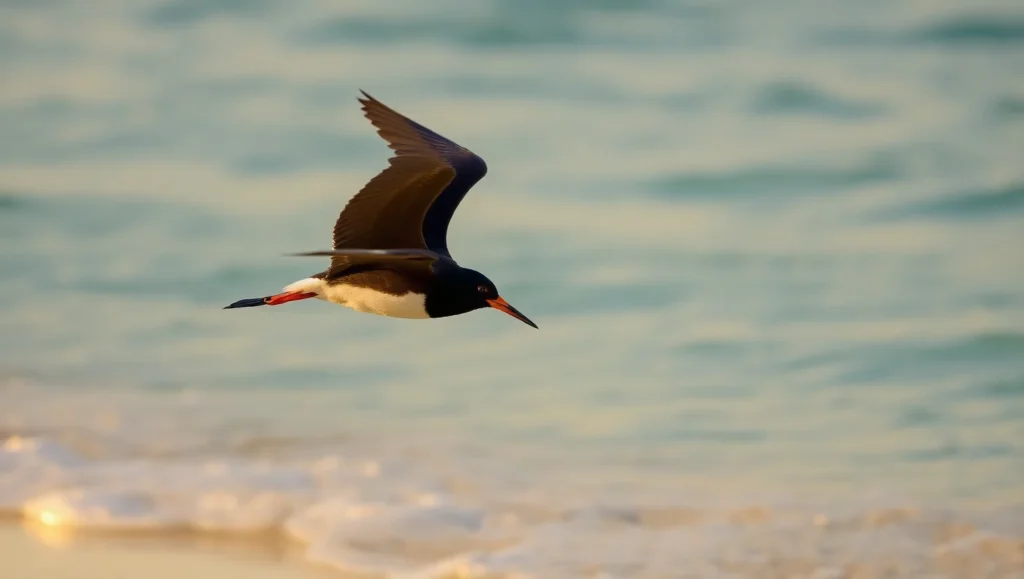
Cape Lookout provides numerous colonies of southern black and brown skimmer, enabling jaw-dropping sunset views for bathers and bird watchers alike. The black and brown backs of skimmer birds while gradually changing to sandy ones is a beauty to watch and a must-have view with the hooting of the bird.
8. Royal Tern – Majestic Divers of the Open Sea:
- Scientific Name: Thalasseus maximus
- Appearance: Large, grayish-white, black cap in summer
- Habitat: Beaches, coastal waters
- Behavior: Dives for fish, harsh calls
- Conservation Status: Stable, needs nesting sites
- Best Viewing Spots: Fort Fisher, Sunset Beach
Royal terns rule North Carolina’s coastal skies. These large seabirds, with wingspans up to four feet, sport grayish-white bodies and black caps during breeding season. They plunge from great heights to snatch fish like mullet, their harsh “keer-reet” calls echoing across beaches.
Nesting in dense colonies on sandy islands, they lay single eggs in shallow scrapes. Their populations remain stable, but protected nesting sites are crucial to shield them from storms and human activity. Fort Fisher’s wide beaches provide ideal viewing, where terns soar and dive in summer, captivating onlookers.
9. Wilson’s Plover – Sturdy Sprinters of the Dunes:
- Scientific Name: Charadrius wilsonia
- Appearance: Stocky, brown back, single breast band
- Habitat: Sandy beaches, flats
- Behavior: Snatches insects, nests in dunes
- Conservation Status: Vulnerable to habitat loss
- Best Viewing Spots: Bird Island, Masonboro Inlet
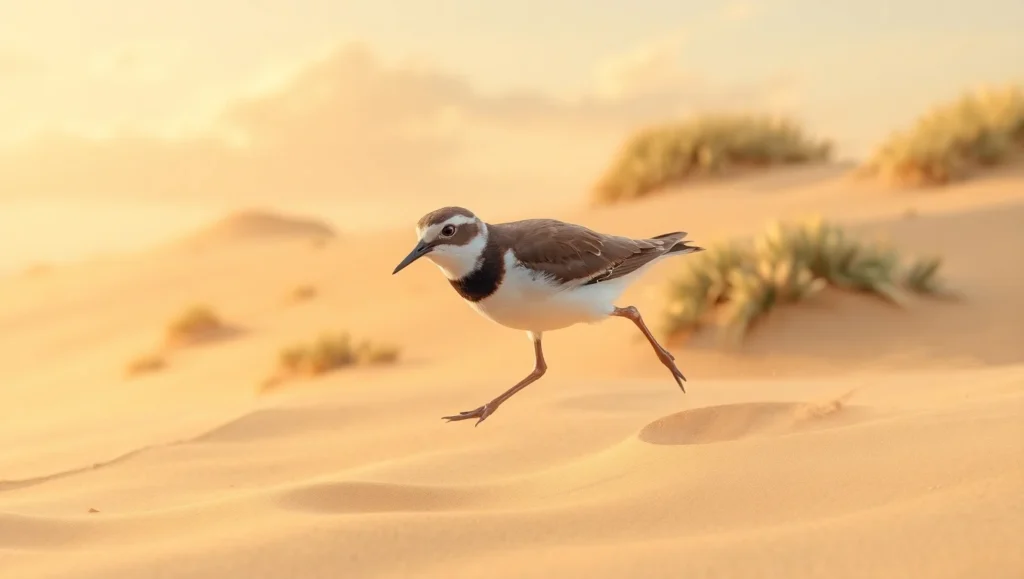
Wilson’s plovers embody resilience on North Carolina’s beaches. Their stocky, brown bodies and single dark breast bands distinguish them from other shorebirds. They sprint along tidelines, snatching insects and small crabs with quick pecks.
Their nests, simple scrapes in dunes, blend perfectly with the surroundings but face threats from high tides and foot traffic. Conservation efforts, including restricted beach access, protect their breeding grounds. Bird Island’s undisturbed shores offer a haven for these plovers, where birders can observe their swift movements in spring.
10. Clapper Rail – Secretive Wanderers of the Marshes:
- Scientific Name: Rallus crepitans
- Appearance: Grayish-brown, long beak, slender
- Habitat: Salt marshes
- Behavior: Scurries through grass, loud clattering
- Conservation Status: Stable, needs marshes
- Best Viewing Spots: Rachel Carson Reserve, Cedar Island
Clapper rails thrive in the hidden world of North Carolina’s salt marshes. Their grayish-brown plumage and slender bodies slip through dense cordgrass, rarely seen but often heard. Their loud, clattering “kek-kek-kek” calls, especially at dusk, betray their presence.
These wading birds probe mud for crabs and snails, seldom flying unless startled. Marsh loss from development and sea-level rise threatens their habitat, but protected reserves ensure their survival. Cedar Island’s marsh trails offer a chance to hear their distinctive calls, though spotting them requires patience.
“The heavens declare the glory of God; the skies proclaim the work of his hands.” – Psalm 19:1
MORE FOR YOU: Do Hummingbirds Have Feet – Guide to Their Tiny Toes!
11. Snowy Egret – Delicate Dancers of the Tidal Pools:
- Scientific Name: Egretta thula
- Appearance: White, black beak, yellow feet
- Habitat: Marshes, tidal pools
- Behavior: Stirs water for prey, graceful
- Conservation Status: Stable, needs wetlands
- Best Viewing Spots: Beaufort, Pea Island
Snowy egrets enchant with their delicate beauty. Their pure white feathers, black beaks, and bright yellow feet create a striking contrast. These wading birds stir shallow waters with their feet, flushing small fish and crustaceans before striking.
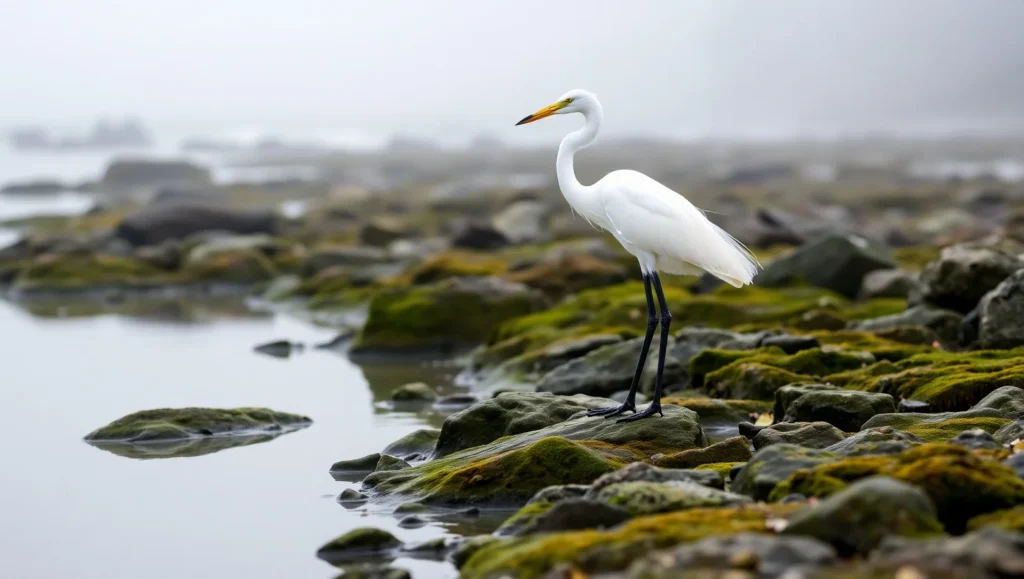
Their graceful movements, almost like a dance, captivate observers. During breeding season, they develop lacy plumes, once hunted nearly to extinction for fashion.
Wetland preservation has stabilized their populations, but pollution remains a risk. Beaufort’s tidal flats, especially at low tide, offer perfect views of their foraging ballet.
12. Reddish Egret – Spirited Performers of the Estuaries:
- Scientific Name: Egretta rufescens
- Appearance: Slate-blue, pinkish beak
- Habitat: Estuaries, lagoons
- Behavior: Dances while foraging, chases fish
- Conservation Status: Stable, rare in NC
- Best Viewing Spots: Cape Lookout, Rachel Carson Reserve
Reddish egrets bring flair to North Carolina’s estuaries. Their slate-blue plumage and pinkish beaks stand out in shallow waters. These wading birds forage with a lively dance, zigzagging and flapping wings to herd fish.
Their energetic antics, unlike the stillness of other herons, make them a rare treat to watch. Though less common in North Carolina, they appear regularly in southern coastal reserves. Undisturbed habitats are vital for their visits. Cape Lookout’s quiet lagoons offer occasional sightings, rewarding patient birders with a vibrant display.
13. Black-bellied Plover – Seasonal Travelers of the Mudflats:
- Scientific Name: Pluvialis squatarola
- Appearance: Black belly in summer, gray in winter
- Habitat: Beaches, mudflats
- Behavior: Probes for worms, whistles
- Conservation Status: Stable, needs clean flats
- Best Viewing Spots: Masonboro Inlet, Wrightsville Beach
Black-bellied plovers adapt to North Carolina’s seasons. Their black bellies and white faces in summer transform to mottled gray in winter, blending with muddy flats. These shorebirds probe beaches for worms and mollusks, their whistling “pee-oo-ee” calls carrying across shores.
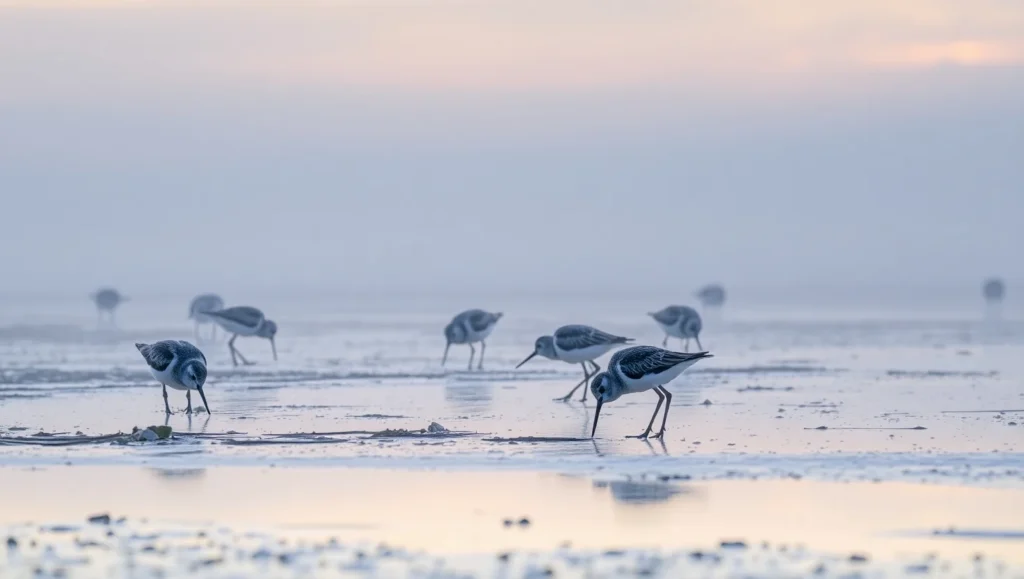
They migrate through the state in spring and fall, stopping to refuel on rich tidal flats. Coastal development threatens their stopover sites, but clean habitats sustain them. Masonboro Inlet’s mudflats teem with plovers during migration, offering birders a chance to see their seasonal shifts.
14. Dunlin – Flocking Foragers of the Tidal Flats:
- Scientific Name: Calidris alpina
- Appearance: Rusty back in summer, gray in winter
- Habitat: Tidal flats, beaches
- Behavior: Probes mud in flocks, quick
- Conservation Status: Stable, sensitive to habitat loss
- Best Viewing Spots: Pea Island, Fort Fisher
Dunlin encompasses North Carolina’s tidal flats. Their summer rust-colored backs and earthy gray winter plumage mark them as versatile foragers. With a swift, probing motion, their beaks uncover mud-buried crustaceans and insects. As they migrate through the state during this time, clean flats are a necessity for winter-straddling refueling.
Although accessible sites that are safe with regards to loss of habitat and pollution make perch guarantees wonder throughout the region, protected places protect flight contrails. Conservation areas provide an observable spectacle at Pea Island, where flats are filled with umbrageous swarms of dunlins in autumn, avid watching sights for migration fans.
15. Laughing Gull – Boisterous Scavengers of the Beaches:
- Scientific Name: Leucophaeus atricilla
- Appearance: Black head in summer, white in winter
- Habitat: Beaches, coastal waters
- Behavior: Scavenges, steals food, “ha-ha” calls
- Conservation Status: Abundant, adaptable
- Best Viewing Spots: Outer Banks, Kure Beach
Laughter accompanied by the temperate depository of North Carolina tells an ecstatic story about the emergence of laughing gulls. Their attitude stems from no winter views, but attitude is identified at the peak of summer eras spent hunting for clues.
Coast beaches are littered with scavengers siphoning resources and harvesting pecked eggs from crown-covered patches, while selfing marks are an easy peep to hear and see. The fearsome approach of gulls is spotted within coastal towns alike.
During winter, stationed near Kure Beach, Gulls can constantly be observed alongside the piers and sands, providing accessible captures for gull observers.
16. Forster’s Tern – Graceful Divers of the Coastal Skies:
- Scientific Name: Sterna forsteri
- Appearance: Black cap in summer, white winter plumage
- Habitat: Coastal waters, marshes
- Behavior: Dives precisely, graceful flight
- Conservation Status: Stable, needs nesting sites
- Best Viewing Spots: Wrightsville Beach, Cape Hatteras
Forster’s terns have the grace of swans as they glide over the waters of North Carolina. In summer, their black caps are replaced with white plumage during winter, highlighting their streamlined figure.
The seabirds can accurately dive and catch fish such as silversides off the surface. Their flight is buoyant and light, comparable to that of a swallow. Forster’s tern nests in a marshy colony where they can remain undisturbed, ensuring stable populations.
Experiencing their elegant dives, especially during summer, can be done in the coastal waters of Wrightsville Beach.
17. Tricolored Heron – Agile Stalkers of the Marshes:
- Scientific Name: Egretta tricolor
- Appearance: Slate-blue, white belly, slender neck
- Habitat: Marshes, estuaries
- Behavior: Stalks prey, agile strikes
- Conservation Status: Stable, needs wetlands
- Best Viewing Spots: Rachel Carson Reserve, Fort Macon
In North Carolina’s marshes, Tricolored herons are known to hunt with great precision. Their slate-blue feathers, white stomachs, and necks emmit a long and slender binary profile. These wading birds catch fish and crustaceans with their rapid and agile movement.
Unlike the other birds, Tricolored herons forage alone, making use of tidal creeks while avoiding fins and flats. Although the loss of wetland puts their habitat in danger, protected areas like Rachel Carson provide rest. Visit low tide at Fort Macon’s marshes to see their relentless and adaptive hunting skills compete with other birds.
18. Sanderling – Wave-Chasing Sprinters of the Shore:
- Scientific Name: Calidris alba
- Appearance: Pale gray, black legs, short beak
- Habitat: Sandy beaches
- Behavior: Chases waves, probes sand
- Conservation Status: Stable, needs clean beaches
- Best Viewing Spots: Outer Banks, Sunset Beach
As North Carolina’s surf rolls in, sanderlings can be seen racing up and down the beach. They frantically search the sand for small crabs and worms as the waves bring them closer to the shore. These shorebirds, often in small flocks, delight tourists at the beach with their persistence.
Their beaks are capable of foraging, lightly digging in the sand. They rely heavily on clean beaches to refuel, which makes migration treacherous. During fall, birdwatchers get to enjoy the splendid sight of sanderlings on Sunset Beach.
19. Great Blue Heron – Towering Guardians of the Wetlands:
- Scientific Name: Ardea herodias
- Appearance: Large, blue-gray, long legs
- Habitat: Marshes, coastal waters
- Behavior: Stands still, spears fish
- Conservation Status: Stable, needs wetlands
- Best Viewing Spots: Pea Island, Cedar Island
North Carolina’s wetlands are home to great blue herons that can be spotted standing still. Their towering blue-grey frames, along with their long legs allow them to overshadow the marshes. These wading birds lie still and ambush fish or frogs with swift movements.
They gracefully move their broad wings over the estuaries and then settle in treetop colonies referred to as rookeries. The population is balanced due to the conservation of wetlands, but pollution is a threat. The trails on Pea Island serve as the perfect location for birdwatching, as they provide the best views of the great blue heron during sunrise.
20. Willet – Vocal Patrollers of the Coastal Flats:
- Scientific Name: Tringa semipalmata
- Appearance: Grayish-brown, black-and-white wings
- Habitat: Beaches, marshes
- Behavior: Probes mud, loud calls
- Conservation Status: Stable, needs clean flats
- Best Viewing Spots: Masonboro Inlet, Fort Fisher
With intention, Willets stride along the shores of North Carolina. Their bodies which are of a dull grayish brown, is similar to the shades of the mudflats, but their wings which are black and white flash with great intensity when they fly.
These shorebirds shout out ‘pill-will-willet’ as they capture crabs and worms from the mud. They lay their eggs in shallow depressions in the grassy marshes. Protected locations guarantee their stability for their clean tidal flats are essential for their foraging. In Morris Inlet’s flats, Willets are found throughout the year, where their songs animate the coast.
“We don’t inherit the earth from our ancestors; we borrow it from our children.” – Native American Proverb
20 Coastal Bird Species – Features and Detailed Descriptions:
| Species | Scientific Name | Key Habitat | Best Viewing Spot |
| Brown Pelican | Pelecanus occidentalis | Coastal waters | Bird Island |
| Piping Plover | Charadrius melodus | Beaches | Pea Island |
| American Oystercatcher | Haematopus palliatus | Barrier islands | Masonboro Inlet |
| Least Tern | Sternula antillarum | Sandy beaches | Sunset Beach |
| Great Egret | Ardea alba | Marshes | Rachel Carson Reserve |
| White Ibis | Eudocimus albus | Tidal flats | Fort Macon |
| Black Skimmer | Rynchops niger | Sandy islands | Cape Lookout |
| Royal Tern | Thalasseus maximus | Beaches | Fort Fisher |
| Wilson’s Plover | Charadrius wilsonia | Sandy beaches | Bird Island |
| Clapper Rail | Rallus crepitans | Salt marshes | Cedar Island |
| Snowy Egret | Egretta thula | Tidal pools | Beaufort |
| Reddish Egret | Egretta rufescens | Estuaries | Cape Lookout |
| Black-bellied Plover | Pluvialis squatarola | Mudflats | Masonboro Inlet |
| Dunlin | Calidris alpina | Tidal flats | Pea Island |
| Laughing Gull | Leucophaeus atricilla | Beaches | Kure Beach |
| Forster’s Tern | Sterna forsteri | Coastal waters | Wrightsville Beach |
| Tricolored Heron | Egretta tricolor | Marshes | Rachel Carson Reserve |
| Sanderling | Calidris alba | Sandy beaches | Sunset Beach |
| Great Blue Heron | Ardea herodias | Marshes | Pea Island |
| Willet | Tringa semipalmata | Beaches | Masonboro Inlet |
Best Birdwatching Spots in North Carolina:
Coastal birds of NC thrive in diverse habitats, from sandy shores to marshy refuges. These locations attract birders with stunning views and abundant species. Explore these top sites to witness their beauty.
Pea Island National Wildlife Refuge – Coastal Birds of NC:
Pea Island, on the Outer Banks, is a haven for wintering waterfowl and migrating terns. Snow geese, tundra swans, and black terns flock here. Trails and observation platforms make it accessible. Visit in late summer for peak migration.
Rachel Carson Reserve:
This reserve, near Beaufort, offers trails through tidal flats. White ibises, Wilson’s plovers, and painted buntings thrive here. Low tide is ideal for spotting feeding shorebirds. Ferries to Cape Lookout enhance the experience.
Wrightsville Beach:
Wrightsville Beach attracts beach-nesting species. American oystercatchers, black skimmers, and least terns are common from April to August. The south end, near Masonboro Inlet, is best for shorebirds.
Bird Island:
Accessible by foot or boat, Bird Island is a sanctuary for brown pelicans and winter sparrows. Its undisturbed beaches host large breeding colonies. Bring binoculars to avoid disturbing nests.
“The bird is powered by its own life and by its motivation.” – A.P.J. Abdul Kalam
Frequently Asked Questions About Coastal Birds of NC:
What are the little birds running on the beach?
Sanderlings are the small birds darting along North Carolina’s beaches. They chase waves to probe the sand for tiny crabs.
What are the most common birds in North Carolina?
Laughing gulls and brown pelicans rank among the most common coastal birds of NC. You’ll spot them on beaches and piers.
What are the black and white sea birds in North Carolina?
The American oystercatcher, with black-and-white plumage and an orange beak, is a common seabird on NC’s shores.
What is the most common beach bird?
Laughing gulls dominate NC’s beaches. Their bold scavenging and “ha-ha” calls make them unmistakable.
Final Thoughts:
They indicate the health of our world and add to our lives with their beauty and ways. From the hardy brown pelican to the fragile piping plover, these birds have challenges but endure due to dedicated conservation. North Carolina’s coastal birds are not just a lovely spectacle.
By traveling to birdwatching spots, being careful in habitats, and contributing to conservation, you can assist in safeguarding these gems. Get out your binoculars, check out the coastline, and see the wonder of North Carolina’s avian residents.
“We don’t inherit the earth from our ancestors; we borrow it from our children.” – Native American Proverb, urging conservation for future generations
